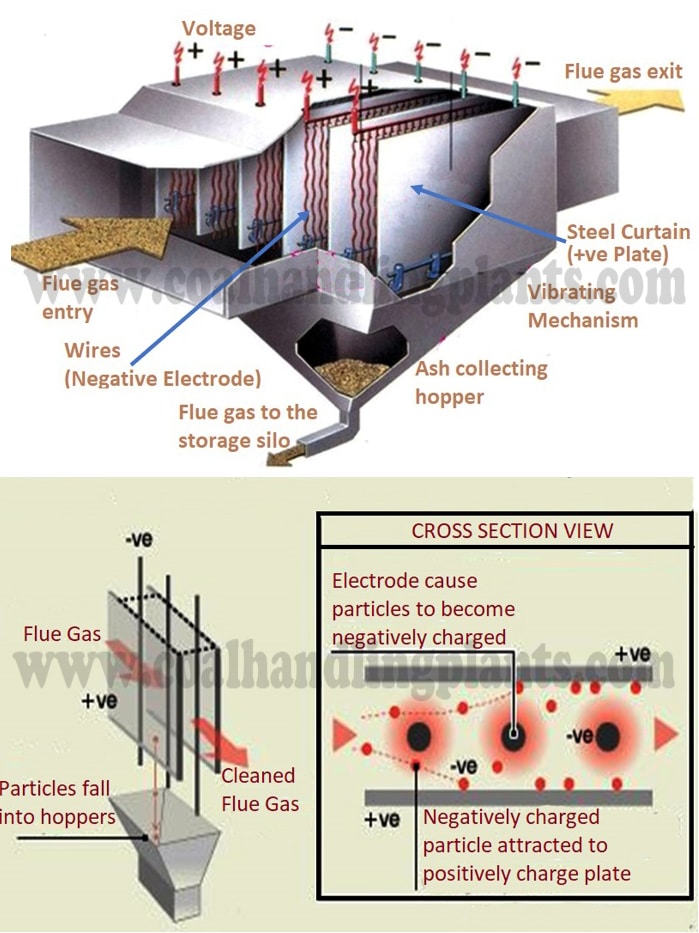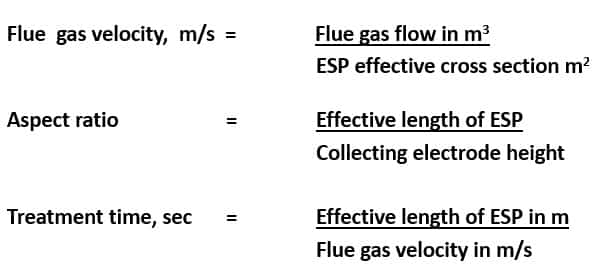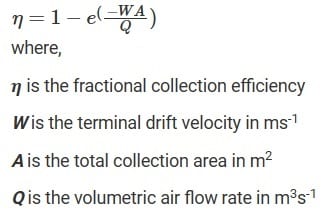Electrostatic Precipitator (ESP) is used to remove fine ash from the flowing flue gases by applying a high-voltage electrostatic charge and collecting the particles on charged plates.
Electrostatic Precipitator Working Principle
The electrostatic Precipitator (ESP) utilizes electrostatic forces to separate dust particles from the gas to be cleaned. The precipitation process involves 4 main functions:
- Corona generation
- Particle charging
- Particle collection
- Removal of particles
The gas is conducted to a chamber containing “curtains” of vertical steel plates. These curtains divide the chamber into a number of paralleled gas passages.
The negative terminal of the high voltage DC source is connected to wires (negative electrodes) and the positive terminal of the DC source is connected to steel curtains (positive plates), thereby creating a strong electrical field between the wires in the framework and the steel curtains.
The electrical field becomes strongest near the surface of the wires. So strong that an electrical discharge “the corona discharge” develops along the wires. The gas is ionized due to the corona discharge and large quantities of positive and negative ions are formed. The positive ions are immediately attracted towards the negative wires by the strength of the field. The negative ions, however, have to traverse the space between the electrode to reach the positive curtains.
End route towards the steel curtains, the ions collide with and adhere to the dust particles in the gas. The particles thereby become electrically charged and also begin to migrate in the same direction as the ions towards the steel curtains and stick on to them. These curtains are rapped periodically to dislodge the deposited dust, which is collected in the hoppers.
Effect of Various Parameters on Electrostatic Precipitator
-
Flue Gas Velocity
- velocity is decided by the gas flow and collection efficiency required
- Higher the gas velocity, higher the carryover of dust particles without collection – Re-entertainment
- Very poor velocity alters the flow distribution and effects settling of dust particles
- optimum velocity depends upon the application will improve the performance.
-
Aspect Ratio
- During the rapping, the falling of dust particle take a trajectory form
- Lower the aspect ratio, the trajectory dust travel along with gas flow without falling in to hoppers – Leads to re-entrainment loss.
- Higher the ratio, performance will be good
- optimum aspect ratio depends on allowable velocity, required collection efficiency and available space.
-
Treatment Time
- Time available for capturing the dust particle
- more treatment time at reasonable velocity improves the collection efficiency
- Probability of capturing the re-entrained partilces improves with time.
Flue gas velocity, Aspect ratio and treatment time is calculated by using below mention formula: 
Efficiency of Electrostatic Precipitator

RELATED SEARCHES:
Ash Handling System in Thermal Power Plant
